Roquefort Cheese Guide: Taste, Pairings, and Serving Tips
With its sharp, complex character and distinct blue marbling, Roquefort has earned its place as one of the most celebrated blue cheeses in the world. Aged in natural caves and steeped in centuries-old tradition, Roquefort represents the height of French cheese craftsmanship. This guide will walk you through everything you need to know—from its storied history to serving suggestions and pairing ideas.
What Is Roquefort Cheese?
Roquefort is a semi-soft, blue-veined cheese made from sheep’s milk. Originating in the south of France, it is ripened in the limestone caves of Roquefort-sur-Soulzon, where it develops its signature veins of blue mold (Penicillium roqueforti). The result is a rich, tangy, and salty flavor profile that deepens with age.
A Protected Name and Place of Origin
Roquefort is one of the few cheeses that holds the AOC (Appellation d’Origine Contrôlée) designation, awarded in 1925. This means that only cheese made in Roquefort-sur-Soulzon using traditional methods and sheep’s milk from specific breeds can be labeled as Roquefort. It is also recognized under the European Union’s PDO (Protected Designation of Origin) status.
The History of Roquefort
Roquefort’s roots trace back thousands of years. According to legend, a young shepherd left his lunch of bread and sheep’s milk cheese in a cave while he followed a maiden. When he returned weeks later, he found his forgotten cheese transformed by mold into something entirely new—and delicious.
Historical records mention Roquefort as early as the 11th century, and by the 15th century, it was legally protected by royal decree. The techniques used to mature the cheese in the region’s natural caves have been passed down through generations.
How Roquefort Is Made
Roquefort is crafted using the unpasteurized milk of Lacaune sheep. After curdling with rennet, the curds are cut and drained, then salted and pierced to allow air into the cheese. This step helps the Penicillium roqueforti mold grow throughout the body of the cheese.
The cheeses are then aged in the cool, humid caves of Roquefort-sur-Soulzon. The unique airflow in these caves, created by narrow vents known as fleurines, plays a crucial role in the maturation process.
What Does Roquefort Taste Like?
Roquefort delivers a bold flavor with a creamy yet crumbly texture. Expect a sharp tanginess balanced by savory saltiness, with underlying notes of nuts, butter, and sometimes even caramel. The blue veins add a sharp pungency that lingers on the palate.
It’s a cheese with presence—commanding, yet refined.
How to Serve Roquefort
To appreciate Roquefort fully, bring it to room temperature before serving. Its aroma and texture are best experienced when it has time to breathe.
Serving suggestions:
-
Crumbled over a green salad with walnuts and pears
-
Spread on a crusty baguette with a drizzle of honey
-
Paired with figs or dried apricots on a cheese board
-
As a topping for grilled steak or roast beef
Pairing Roquefort With Food and Drink
Wine Pairings:
-
Sauternes or other sweet wines for a balanced contrast
-
Port or Sherry for a rich, warming match
-
Robust reds like Cabernet Sauvignon or Malbec
Other Pairings:
-
Honey, fruit preserves, or aged balsamic vinegar
-
Rustic breads or crackers
-
Cured meats, especially thinly sliced prosciutto
Culinary Uses for Roquefort
Roquefort brings depth and saltiness to many dishes. Use it sparingly—it’s powerful.
-
Melt into cream for a decadent pasta sauce
-
Stir into mashed potatoes or polenta for bold flavor
-
Crumble into omelets or savory tarts
-
Fold into compound butter and spread over grilled meats
How to Store Roquefort Properly
Wrap Roquefort in wax paper or parchment and store it in the vegetable drawer of the fridge. Avoid plastic wrap, which traps moisture and affects its flavor. Kept properly, Roquefort can last up to three weeks once opened.
To preserve its bold aroma, consider storing it separately from milder cheeses.
Roquefort vs. Other Blue Cheeses
While there are many beloved blue cheeses in the world—Gorgonzola, Stilton, Bleu d’Auvergne—Roquefort stands apart for several reasons:
-
Made only from sheep’s milk
-
Aged in unique natural caves
-
Distinctly sharp, salty, and creamy
-
Governed by strict AOC guidelines
If blue cheese is a category, Roquefort is the benchmark.
Is Roquefort Nutritious?
Roquefort is rich in calcium and protein, making it a good addition in moderation. It also contains vitamins A and B12. However, it is high in sodium and saturated fat, so portion control is recommended.
Some studies have even suggested that Roquefort contains anti-inflammatory properties, possibly due to its unique mold strains.
Fun Facts About Roquefort
-
Charles de Gaulle once lamented managing a country with “246 kinds of cheese,” but Roquefort remained one of his personal favorites.
-
Roquefort caves maintain near-perfect conditions year-round without artificial control.
-
Penicillium roqueforti used to be collected by bread left to mold in the caves.
Roquefort’s Lasting Legacy
Roquefort represents more than culinary excellence—it carries with it a story of heritage, climate, and craft. With its bold taste and unmistakable character, Roquefort has shaped the identity of French cheese both at home and abroad. Whether served at a festive gathering or savored in a quiet moment, it leaves a lasting impression.
FAQs
1. Is Roquefort suitable for vegetarians?
Traditional Roquefort uses animal rennet, so it is not vegetarian unless specified.
2. Can Roquefort be frozen?
Freezing is not recommended, as it alters the texture and compromises the flavor.
3. What’s the best way to soften Roquefort before serving?
Let it sit at room temperature for 30–45 minutes before serving.
4. Why is Roquefort so salty?
The salting process is part of its traditional production and aids in mold development and preservation.
5. Does Roquefort pair well with beer?
Yes—try pairing it with a Belgian Dubbel or strong dark ale for a robust match.









